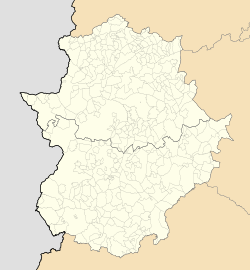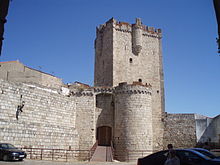Coria, Cáceres
Coria | |
|---|---|
municipality | |
 Coria Cathedral | |
 Seal | |
 Coria Location in Spain Show map of Extremadura  Coria Coria (Spain) Show map of Spain | |
| Coordinates: 39°59′N 6°32′W / 39.983°N 6.533°W / 39.983; -6.533Coordinates: 39°59′N 6°32′W / 39.983°N 6.533°W / 39.983; -6.533 | |
| Country | |
| Autonomous community | |
| Province | |
| Comarca | Vegas del Alagón |
| Government | |
| • Mayor | José Manuel García Ballester (PP) |
| Area | |
| • Total | 103.46 km2 (39.95 sq mi) |
| Elevation | 280 m (920 ft) |
| Population (2017) | |
| • Total | 12,729 |
| • Density | 120/km2 (320/sq mi) |
| Demonym(s) | Caurienses or Corianos |
| Time zone | UTC+1 (CET) |
| • Summer (DST) | UTC+2 (CEST) |
| Website | Official website |
Coria is a Spanish municipality in the province of Cáceres, Extremadura, formed by the city of the same name and the towns of Puebla de Argeme and Rincón del Obispo. The whole municipality has 12,896 inhabitants and a population density of 152.2 inhabitants/km ² (INE 2009), which makes this city the capital of Vegas de Alagón and the fourth largest city in the province of Cáceres.
Founded before the Romans occupied the Iberian Peninsula, and called Caura, the Romans gave it its present name in Latin, Caurium, and later the city was granted Roman citizenship. Later under the Visigoths, the Diocese of Coria was created and, except for the years of Muslim occupation, held at the Episcopal Coria until the twentieth century, when it was forced to share the capital of the diocese in Cáceres.
The centuries in which Coria was the only capital of the diocese were of great prosperity for the city. After the Reconquista, Coria became the capital of a lordship to which some towns are still named after, such as Guijo de Coria or Casillas de Coria. After the dissolution, Coria became the judicial capital of Coria.
Today, Coria is the largest city in the northwest of the province of Cáceres and an important commercial and tourist center, to preserve many monuments and hold an annual national tourist interest in honor of San Juan.
History
Coria was taken twice during the Reconquista, firstly after 1085. It was conquered by the Almoravids just after 1109 and unsuccessfully besieged in 1138. The second and permanent conquest was after a two-month siege in 1142.
Main sights
- Roman walls (3rd-4th centuries AD)
Cathedral of Santa María de la Asunción, in transitional Gothic style
- Bishop's palace (1628)
- Castle of Coria (1472-1478)
- Baroque Hermitage of Nuestra Señora de Argeme (17th century)
- Royal Prisons (1686)
- Old Bridge (Puente Viejo), dating to the 15th-16th centuries
- Convent of the Madre de Dios, founded in the 13th century. The current structure dates to the 14th-16th centuries
- Church of Santiago, in Baroque style (16th-18th centuries)
- Palaces of the Dukes of Alba (15th-16th centuries)
 Coria castle |  Coria old bridge |
 Coria sunset after rain |  Coria bull-running square |
See also
- Roman Catholic Diocese of Coria-Cáceres
| Wikimedia Commons has media related to Coria. |